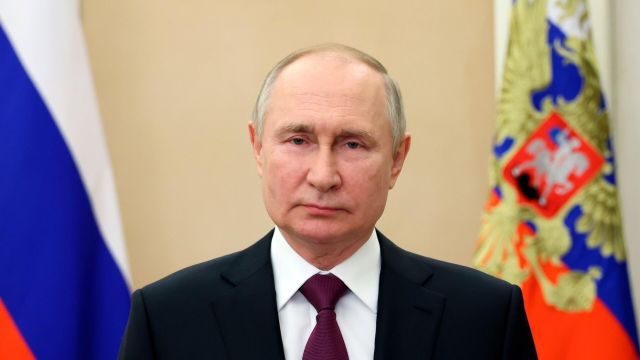The President will also talk with young specialists
KOROLEV, October 26. /tass/. Russian President Vladimir Putin arrived in Korolev, where the Rocket and Space Corporation (RSC) Energia is located. Here the head of state will talk with young specialists and hold a meeting on the development of the rocket and space industry.
Earlier, presidential press secretary Dmitry Peskov announced a "thorough conversation" between Putin and scientists. He also said that the meeting will include reports by the head of Roscosmos, Yuri Borisov, on strategic directions for the development of space activities in the Russian Federation, a report by the general designer of RSC Energia, Vladimir Solovyov, on the prospects for the development of domestic manned cosmonautics, reports by the President of the Russian Academy of Sciences, Gennady Krasnikov, and the head of the FMBA, Veronika Skvortsova.
The history of RSC Energia began in 1946, when the company, under the leadership of Sergei Korolev, developed the first ballistic missiles in the USSR, which laid the foundation for the country's nuclear missile shield. On the basis of the legendary "seven" (R-7), the company created space launch vehicles "Sputnik", "Vostok", "Voskhod", "Luna", "Lightning" and "Soyuz". The corporation also made the first artificial Earth satellite, the first Vostok and Voskhod spacecraft, created the first automatic interplanetary stations that reached the Moon, Venus, Mars, and built the Salyut and Mir orbital stations.
RSC Energia is the main developer of Russian modules for the International Space Station (ISS), which ensures their launch and operation in orbit, as well as the launch of Soyuz manned spacecraft and Progress cargo spacecraft.
The corporation's website emphasizes that the company is working on the creation of a new generation manned transport vehicle and the preliminary design of a new promising Russian orbital station (ROS), DM-type upper stages are being manufactured to support spacecraft launches, new automatic spacecraft are being developed.
Young professionals
In 2022, the industry movement "Team of the Future" was formed in the rocket and space industry, which is headed by the Council of Young Scientists and Specialists under the General Director of the state Corporation Roscosmos. It included more than 30 young scientists and specialists - representatives of Roscosmos organizations, who passed a competitive selection and presented project ideas to the expert commission. The "Team of the Future" is engaged in the search and support of promising scientific and technical projects among young scientists and industry specialists, developing proposals to stimulate young scientists and specialists, creating conditions for their professional growth, popularizing scientific and technical creativity among children and youth.
Exhibition of projects
An exhibition on promising tasks and projects of the rocket and space industry has been prepared for the arrival of the President at RSC Energia. Thus, the exposition includes devices of the federal project "Sphere" - demonstrators of the spacecraft "Skif-D" and "Marathon-IoT", as well as models of serial spacecraft. "Skif-D" is the first spacecraft of the medium-orbital satellite communication system created under the federal project "Sphere". The spacecraft was successfully launched into orbit on October 22, 2022 from the Vostochny Cosmodrome.
The Skif system should include 12 spacecraft in circular polar orbits with a height of 8,070 km, located in three orbital planes, four spacecraft in each. The operation of the system will provide round-the-clock broadband satellite Internet to the entire territory of Russia, including the regions of the Far North and the Arctic.
The Marathon-IoT grouping should include 264 devices weighing 50-75 kg each. They will be placed in 12 orbital planes at an altitude of about 750 km, the active life of each device will be at least five years.
The operation of the system will provide communication for IoT devices - the Internet of Things, the transmission of control commands to unmanned aerial vehicles, as well as data transmission for an aviation system of automatic dependent surveillance of broadcast type.
The exhibition also presents engines of small spacecraft manufactured by the Keldysh Center, Kaliningrad JSC OKB Fakel and VNIIEM Corporation, the latest integrated monitoring system for near-Earth space "Milky Way". The architecture of the Milky Way system will consist of ground and space segments built on optical, radar and radio monitoring equipment. All measuring information about man-made conditions, space weather and dangerous asteroids will be processed in the information and analytical center of the Milky Way system. With the help of ground-based telescopes, high orbits will be observed, low orbits will be monitored by barrier and tracking radars.
Novelties of space technology
Among the novelties of space technology are the promising launch vehicle "Amur-LNG" and the transport energy module "Amur-LNG". The two-stage medium-class launch vehicle will have a reusable (up to ten times) returnable first stage equipped with RD-0169 engines that run on oxygen and liquefied natural gas - methane. Experts assure that the Amur-LNG rocket is being created in accordance with the global trends of modern rocket engineering, including reusable use, the use of modern additive technologies and composite materials, the use of liquefied natural gas as fuel, reducing the cost of launch services and designing for a given cost."
In the Kremlin's materials for Putin's visit to RSC Energia, it is noted that the first Amur-LNG space rocket complex will be created at the Vostochny cosmodrome. The transport and energy module is a Russian space vehicle under development (an interorbital tug). The creation of the module is part of the development on the basis of a nuclear power plant, it is a joint project of the enterprises of Roscosmos and Rosatom. The transport and energy module is being created as a vehicle for solving many tasks, including cargo delivery to the Moon orbit, geostationary orbit, trajectories to the planets of the Solar System (both to Mars and beyond), as well as to combat debris in Earth orbit.
The exhibition also presents promising space services and a promising grouping of private cosmonautics.

